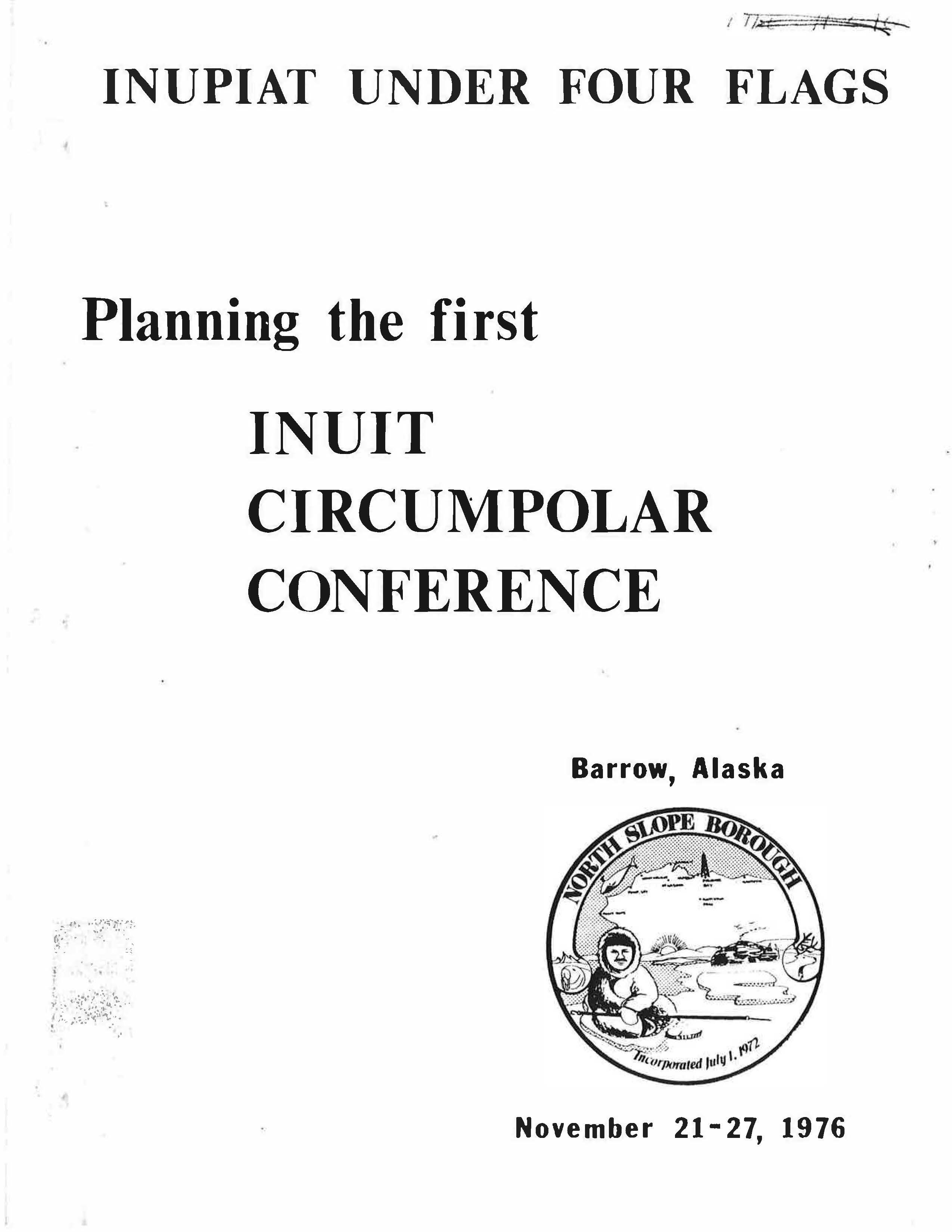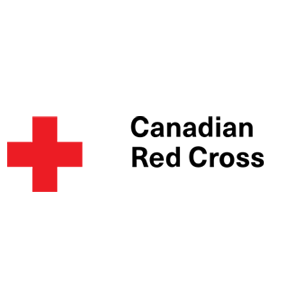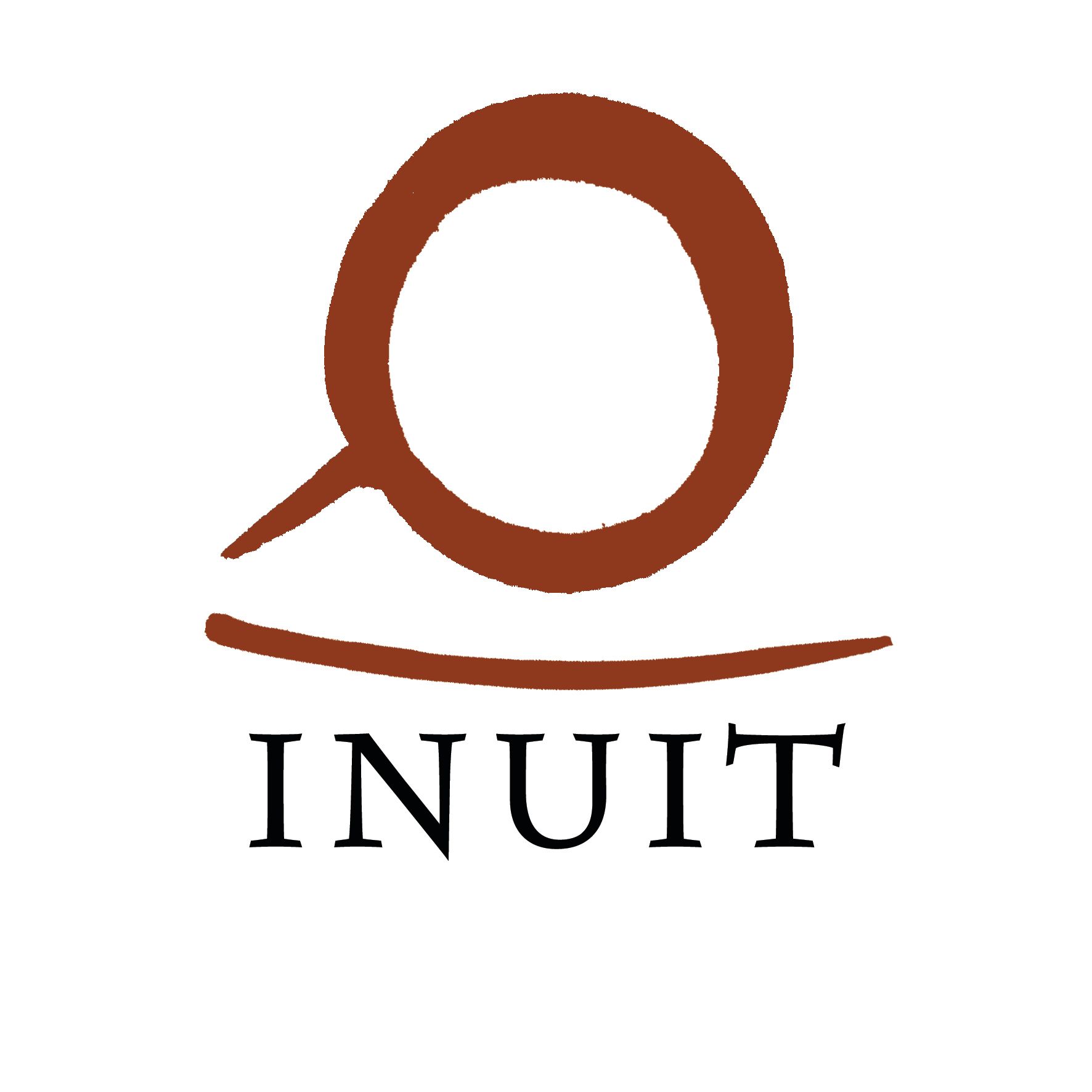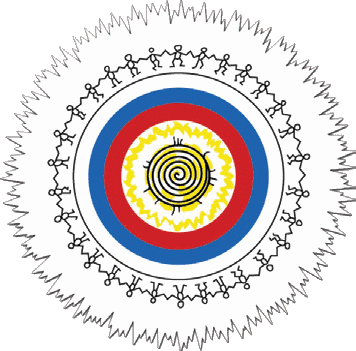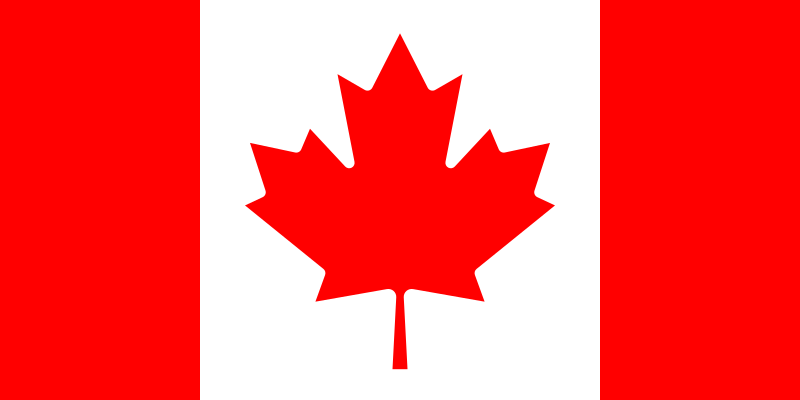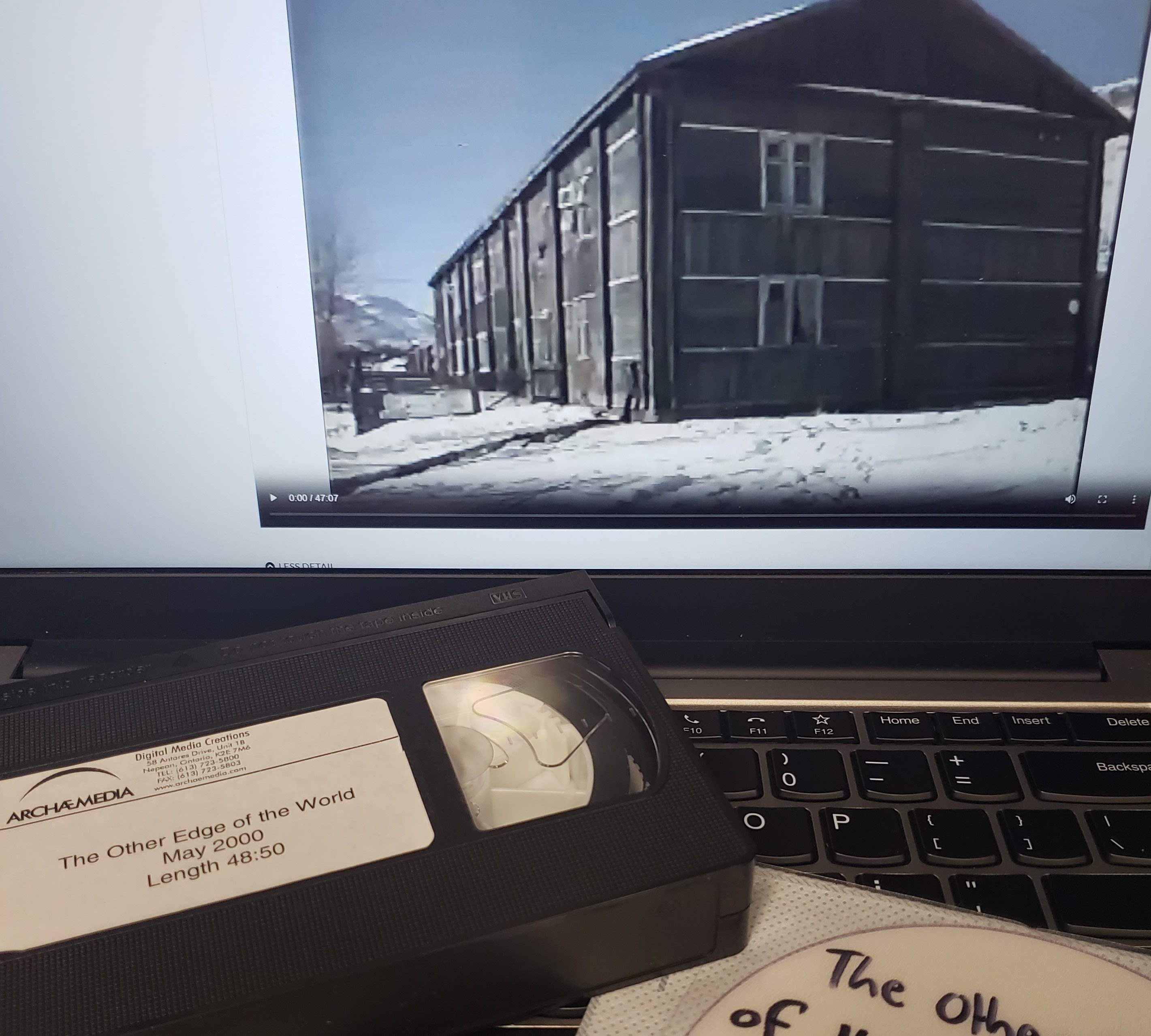The Inuit Express
ICC Canada's Humanitarian Aid to Post-USSR Chukotka
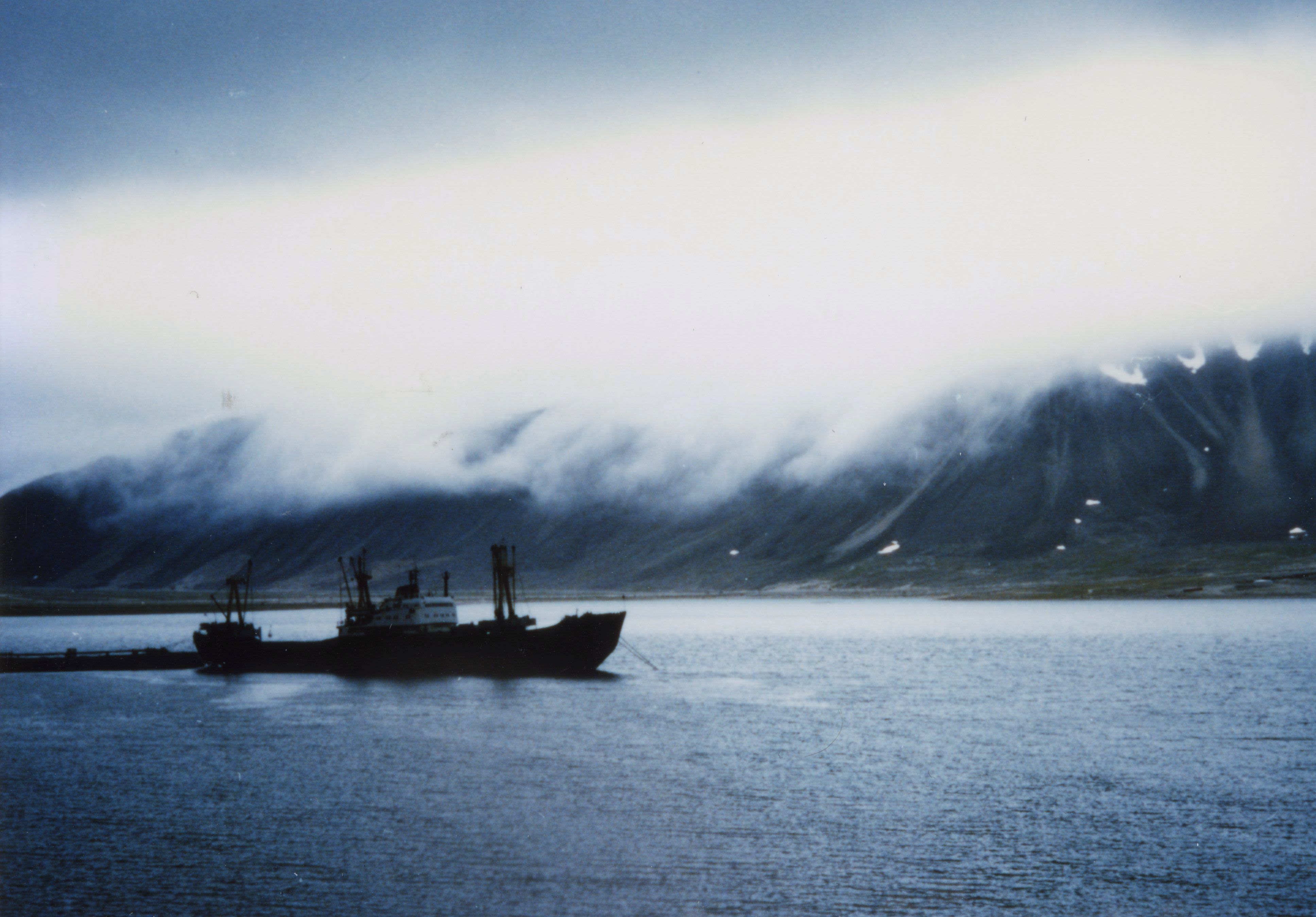
This story starts to take shape
at the first Inuit Circumpolar Conference in Utqiaġvik in 1977...
The Early History of ICC in Russia
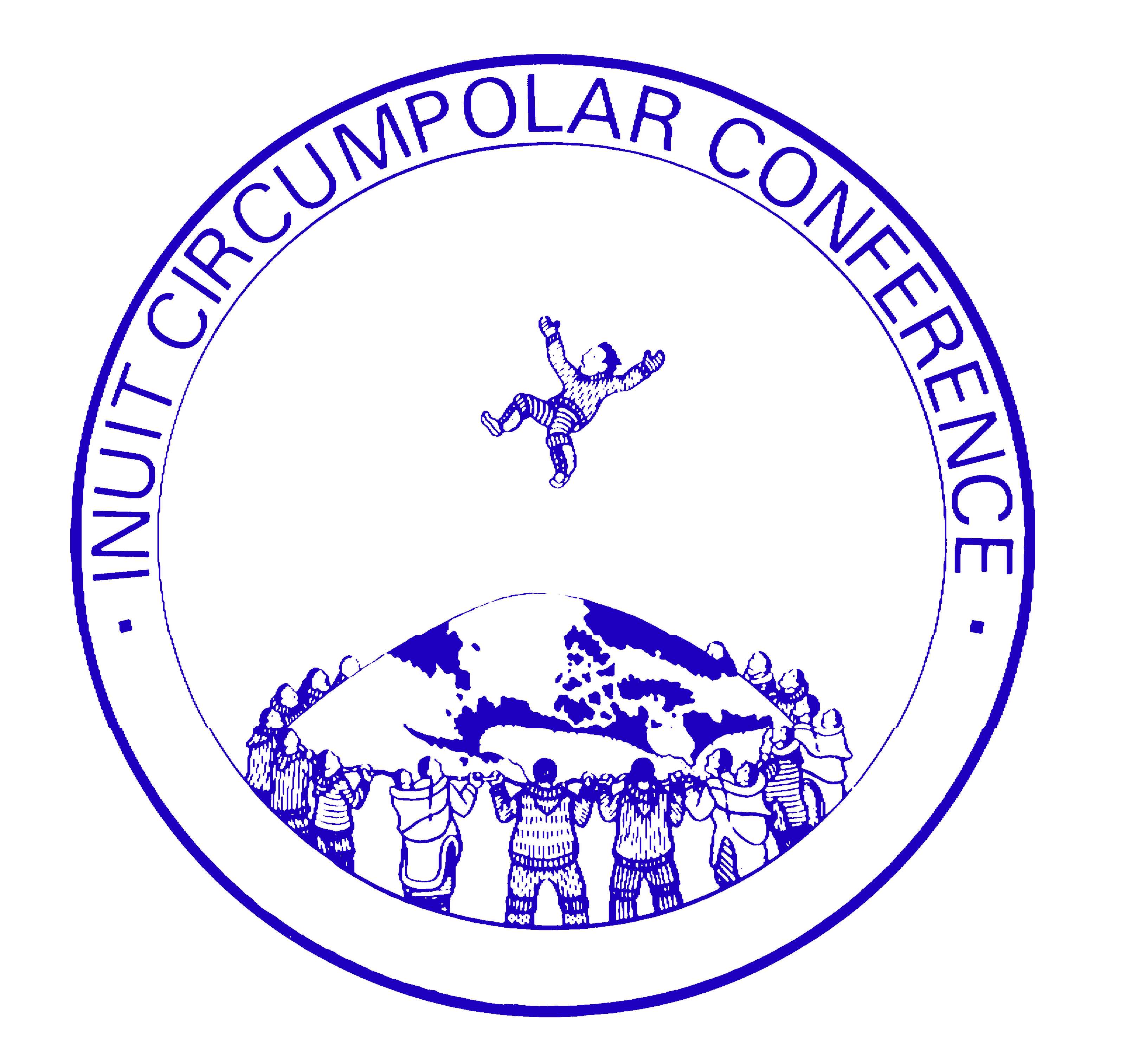
Utqiagvik, 1977
"Inupiat Under Four Flags"
That was one of the mottos for the first ever Inuit Circumpolar Conference.
Held in Utqiaġvik (Barrow), Alaska, ICC's founder Eben Hopson wanted to bring together all Inuit from across the world.
Four flags were displayed at the conference to honour Inuit living in Alaska, Canada, Greenland, and Chukotka.
Despite these hopes, no Inuit from Russia were able to attend the conference in 1977 due to restrictions on travel and communication between the USSR and the other three countries.
ICC was first established with only three regions: Alaska, Canada, and Greenland. However, ICC wasn't content to stay that way - we kept working to connect with our fellow Inuit living in Russia for over a decade.
Iqaluit, 1983
In 1983, ICC was still disappointed that no Inuit from Chukotka were able to join our General Assembly.
However, this year marked an official declaration from ICC that a seat would always be left open for the Inuit of Chukotka.
When announcing this, the ICC Executive Council made a sincere request that the Soviet Union allow fellow Inuit - family members, in many cases - to join the conference.
ICC President Hans-Pavia Rosing and Alaskan representative Caleb Pungowiyi speak at the press conference on Siberian Inuit. Copyright Inuit Broadcasting Corporation.
ICC President Hans-Pavia Rosing and Alaskan representative Caleb Pungowiyi speak at the press conference on Siberian Inuit. Copyright Inuit Broadcasting Corporation.
You can watch the full video of this press conference in the ICC Canada Archives.
At the 1983 conference, both a Soviet flag and an empty chair were set out at the head table alongside the flags of the other three Inuit regions, symbolizing ICC's commitment to our promise: all Inuit, under four flags.
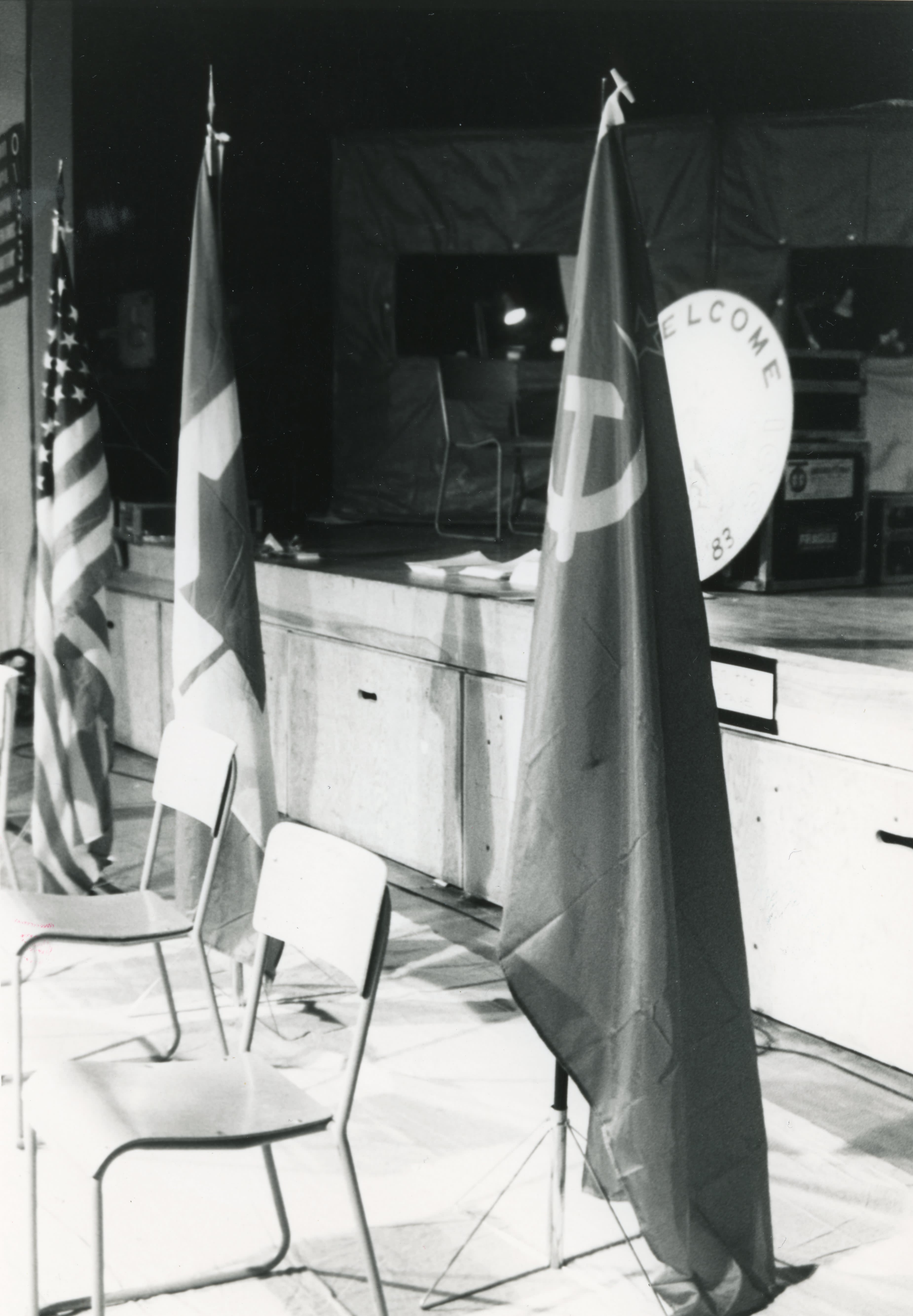
In the summer of 1988, ICC leaders voyaged to Chukotka to ask the Soviet government to allow our fellow Inuit to join us.
Upon landing in Anadyr, Russia, ICC was greeted with a heartfelt welcome from local leaders and community members.
"There was a dance group from Chukotka who welcomed us with some beautiful dances to the accompaniment of drums and songs. Flowers were distributed and almost all of us received a beautiful bouquet."
It was the first time in many years that Inuit from all around the world were able to celebrate our shared culture together.
In 1989, Inuit from Chukotka joined us at the ICC General Assembly in Sisimiut, Kalaallit Nunaat (Greenland).
Although the Soviet government only allowed them to come as observers, we welcomed them with open arms.
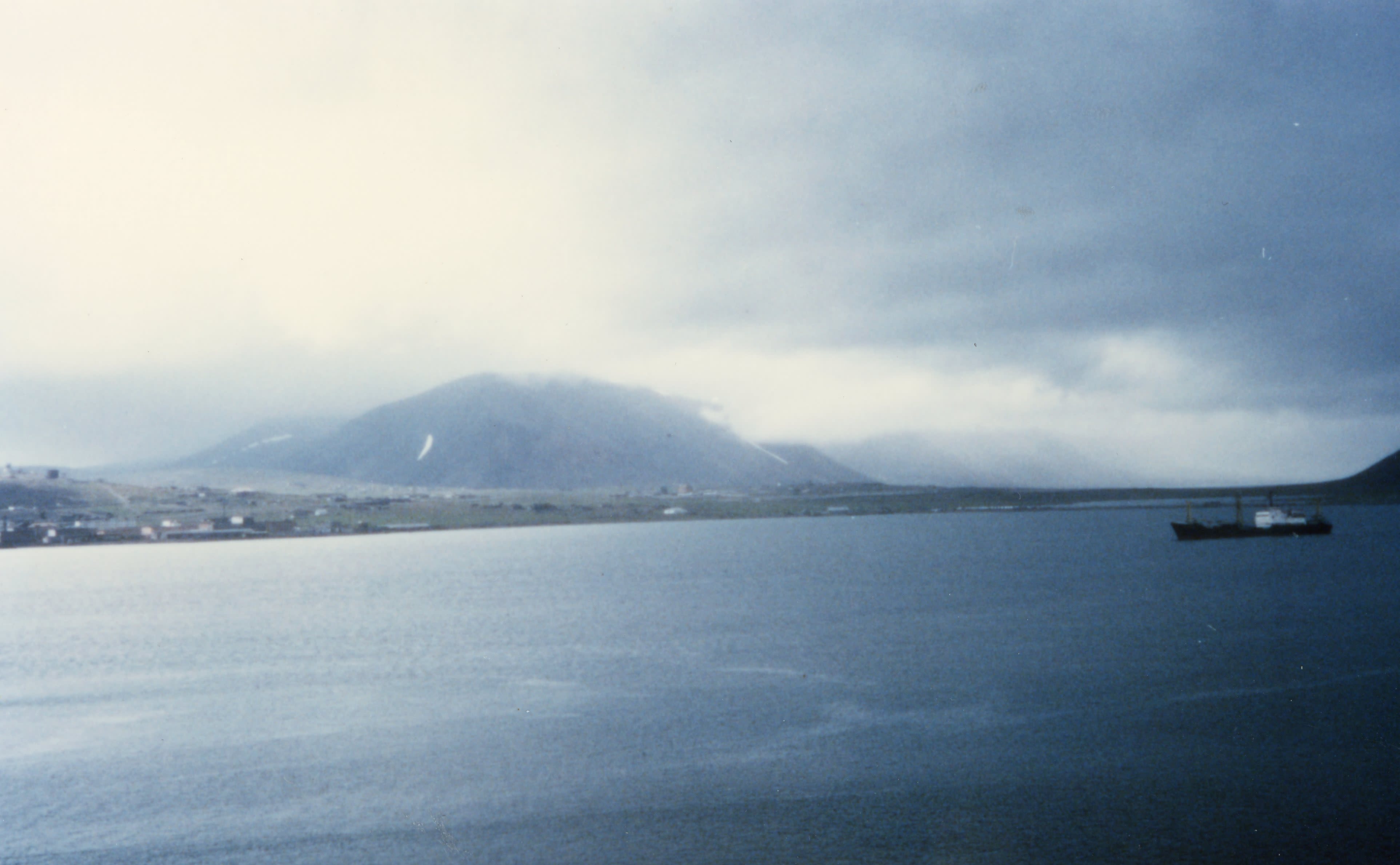

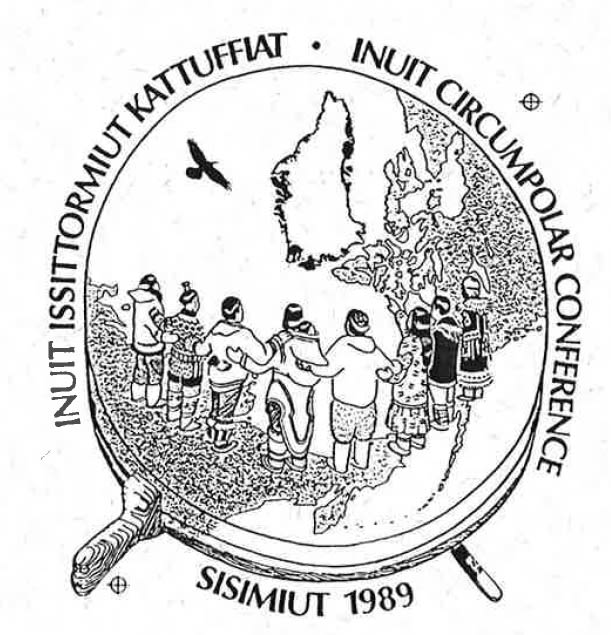
Logo from the 1989 ICC General Assembly. Image credit: ICC Canada Archives.
Logo from the 1989 ICC General Assembly. Image credit: ICC Canada Archives.
"When we come back [to Chukotka], we will share our impressions, what we have seen here and what we have heard [at the ICC General Assembly]. I think we have much in common, despite different dialects we have, we find that we have many common traditions, common issues to discuss, common problems, there is not much that divides us..."
- Interview with Nadezda Sudakova, Russian ex-officio delegate at the 1989 General Assembly in Sisimiut, Greenland.
Inuvik, 1992
Although some Inuit from Chukotka were able to attend the ICC General Assembly in 1989, it wasn't until 1992 that they joined the ICC with full participation and voting rights.
You can see the first Executive Council members from Chukotka on the left: Alexander Omrypkir and Nadezda Sudakova.
After the 1992 General Assembly, ICC worked to establish an ICC Russia office to support our fellow Inuit. Today, that branch is called ICC Chukotka.
Unfortunately, Inuit in Russia still did not have easy lives.
The Soviet Union became more and more unstable, and life for people in Chukotka became increasingly difficult.
The Collapse of the USSR
In 1991, the Soviet Union fell apart. As the government broke down, so did the support systems that people relied on.
"The banking chaos across Russia, with sharp variations in currency rate exchanges, has fuelled price increases and shortages, as storekeepers hold back their goods for more favourable prices. Salaries and pensions - if these have been paid at all - have been reduced by half."
Shortly after the USSR collapsed, the harvest was bad and food supplies were low all across Russia. Government officials responded by claiming that food would be rationed to prevent price increases.
Almost overnight, the price of bread rose by 600%.
There was no way of knowing what could be coming from one day to the next. Money could become worthless in an afternoon.
There was no support system you could rely on, even when facing disaster after disaster.
The people of the far north faced the same crisis as the rest of Russia with even less access to help. Settlements were abandoned as jobs disappeared. Those who could not move away were left to struggle alone, and Indigenous Peoples were especially in trouble.
Soviet policies had brought Indigenous Peoples into large communities away from the land and disrupted traditional practices like reindeer herding and hunting. The people of Chukotka had lost their independence and could no longer provide for themselves through their traditional ways of life. Fuel, food, and healthcare all depended on support from the state.
Now, without that support, they began to starve.

Statue in Provideniya, 1999. Photo credit: Harald Finkler (DIAND/ICC Canada).
Statue in Provideniya, 1999. Photo credit: Harald Finkler (DIAND/ICC Canada).
Provideniya, 1994
In 1994, ICC's Executive Council held a meeting in Provideniya, Russia, focused on the issues that the Indigenous Peoples in Chukotka were facing.
More information about the meeting is available in the ICC Canada Archives.
The ICC Executive Council spoke with representatives from the Russian government and Indigenous organizations. Both asked for cooperation from ICC, explaining the extreme difficulties the people of Chukotka were living with.
'There are many similar problems across the circumpolar region, but ... in Chukotka these are intensified because of the political and economic situation in Russia.'
At the time of the meeting, ICC Greenland was working on a medical aid mission to Chukotka - but all of ICC was determined to help. However, in 1994, most of what we could do was lobby governments and search for funding for ICC's office in Russia. ICC Canada had ideas for future assistance, but we needed time to organize and raise money.
'The situation for the native peoples of Chukotka has also been worsened by the erosion of native cultures ... [I urge] ICC to work together with all of the Indigenous groups in Chukotka.'
ICC leaders left the meeting with an idea: that we could provide help by working directly with Chukotkan Indigenous organizations.
The situation in Chukotka was bad for years
And then things went from bad to crisis
A Winter Emergency
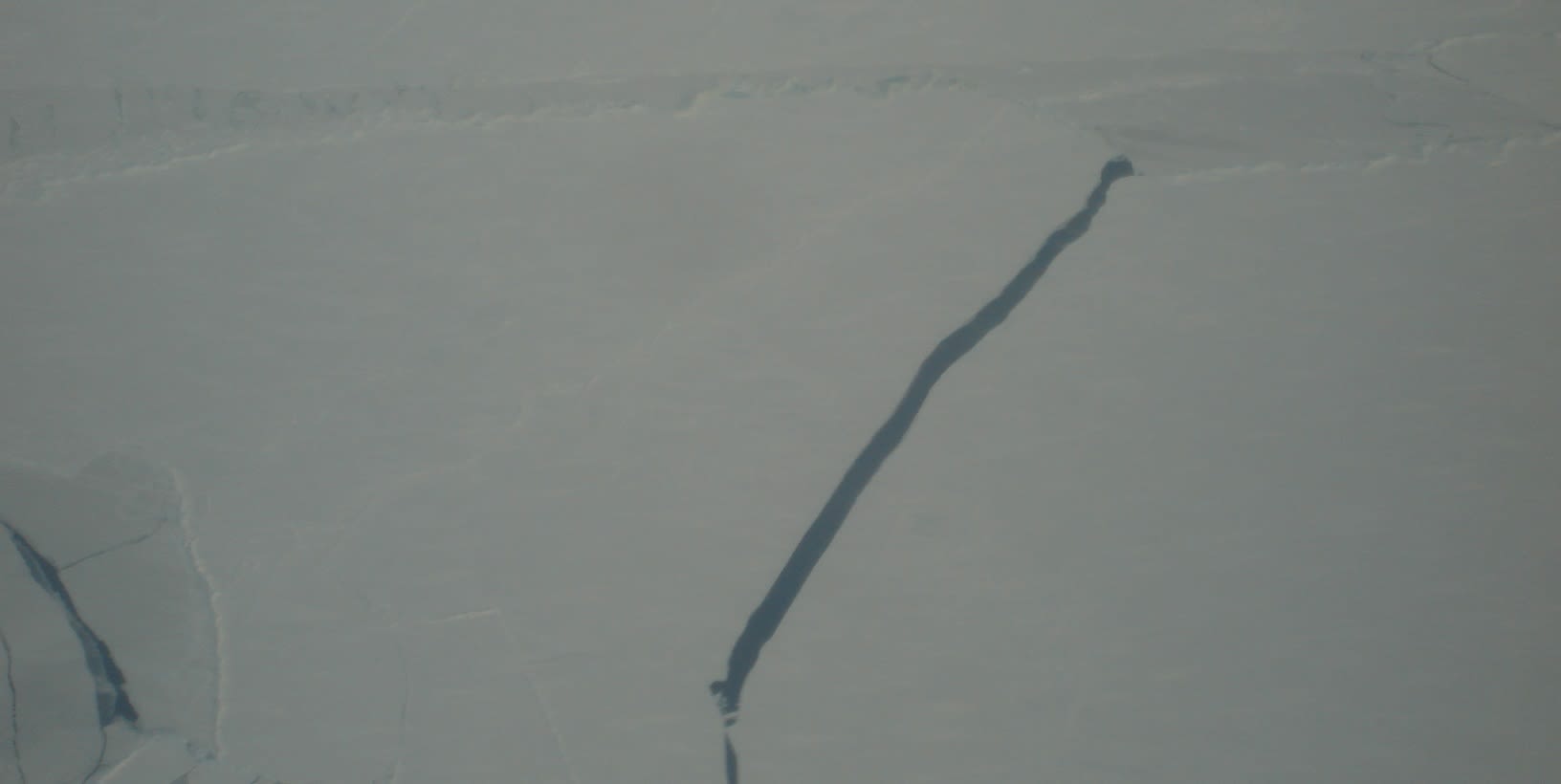
"The native people of Chukotka find themselves in their darkest hour."
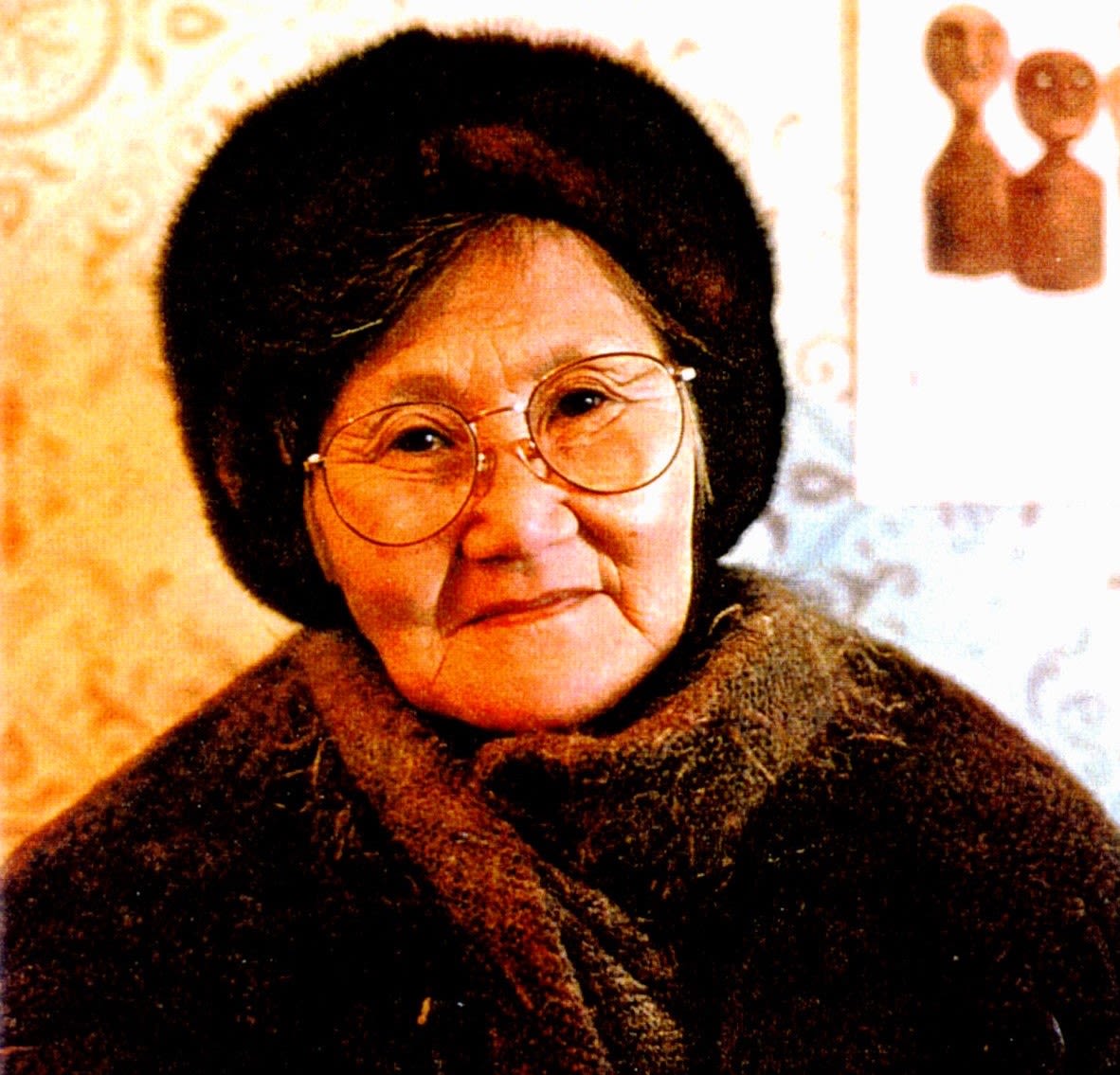
- Liudmila Ainana, President of the Yupik Society of Chukotka, 1999. Photo credit: Harald Finkler (DIAND/ICC Canada).
- Liudmila Ainana, President of the Yupik Society of Chukotka, 1999. Photo credit: Harald Finkler (DIAND/ICC Canada).
Economic crises and dangerous winters were disastrous for the former regions of the USSR in the late 1990s.
The far northeastern regions of Russia, Chukotka, Kamchatka, and Magadan, were isolated and hit with extreme weather. Infrastructure, healthcare, and communications were very limited.
The Russian Association of Indigenous Peoples of the North (RAIPON) reached out to Canada for help in 1998. They asked for humanitarian aid at the Arctic Council, from ICC, and even from the Canadian Government.
The International Federation of the Red Cross reported grimly in a 1999 appeal for aid (learn more on ICC Canada Archives) that:
"Mass migration has started, with doctors among the first to move; those persons who stay are the most vulnerable who have few options but to attempt to survive the extremely hostile conditions with little or no replenishment of basic supplies.
Under these conditions, the Indigenous people (Inuit, Evenk, Koryak, Chukchi, Eskimo, and Aleut) as well as families of economic migrants are desperately hard-pressed to survive."
The communities of the far northeast of Russia, vulnerable and isolated from aid, needed international assistance - and needed it immediately.
Canadian organizations got to work.

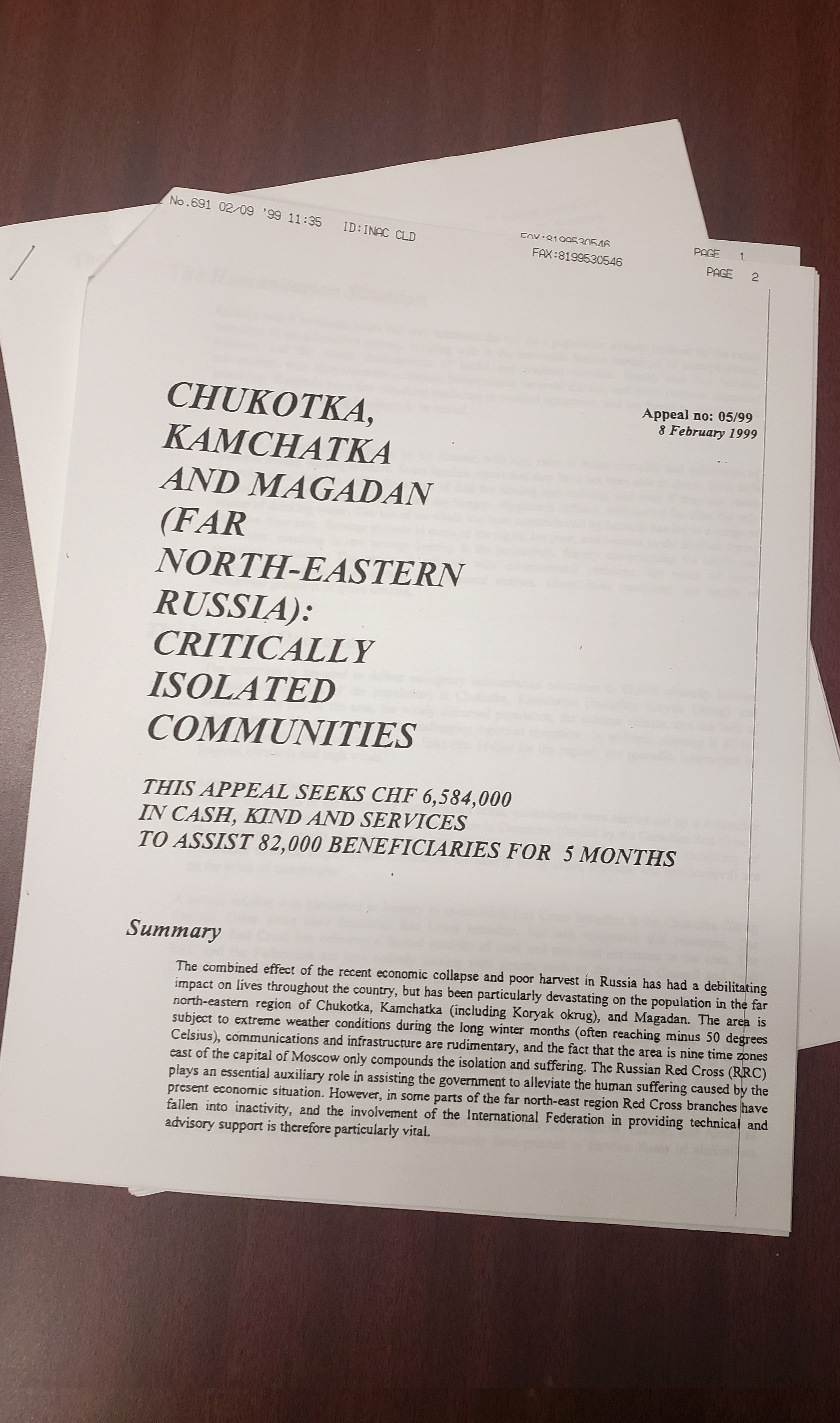
The Humanitarian Assistance Project
In the fall of 1998, Circumpolar Ambassador Mary Simon brought together a committee of government and non-governmental organizations to respond to the crisis in Russia. In November 1998, an official Canadian offer of humanitarian assistance was accepted by the Russian Prime Minister.
Working with the International and Russian Red Cross, these organizations worked together to provide aid to the far northeast of Russia, starting with Chukotka:
"As Indigenous Peoples are a major target for humanitarian assistance, it is particularly important that their representative organizations be involved in the IFRC/RCC operation. The Indigenous Peoples do not want to be seen solely as passive recipients of aid. Instead, they wish to be actively involved in this project as a means of managing their own crisis and building their own capacity."
- 1999 ICC Canada/RAIPON/Canadian Red Cross proposal to CIDA.
See file description in ICC Canada Archives.
"Even if Red Cross/Red Crescent efforts only effect lives in the short term, such efforts still bring hope, a sense of people who care, and a semblance of dignity to the growing number of the world's most vulnerable."
- Margareta Wahlstrom, under secretary-general responsible for disaster response for the IFRC, in an interview with RadioFreeEurope/RadioLiberty, March 1999.

Title from news article in the Christian Science Monitor, January 8, 1999.
Title from news article in the Christian Science Monitor, January 8, 1999.
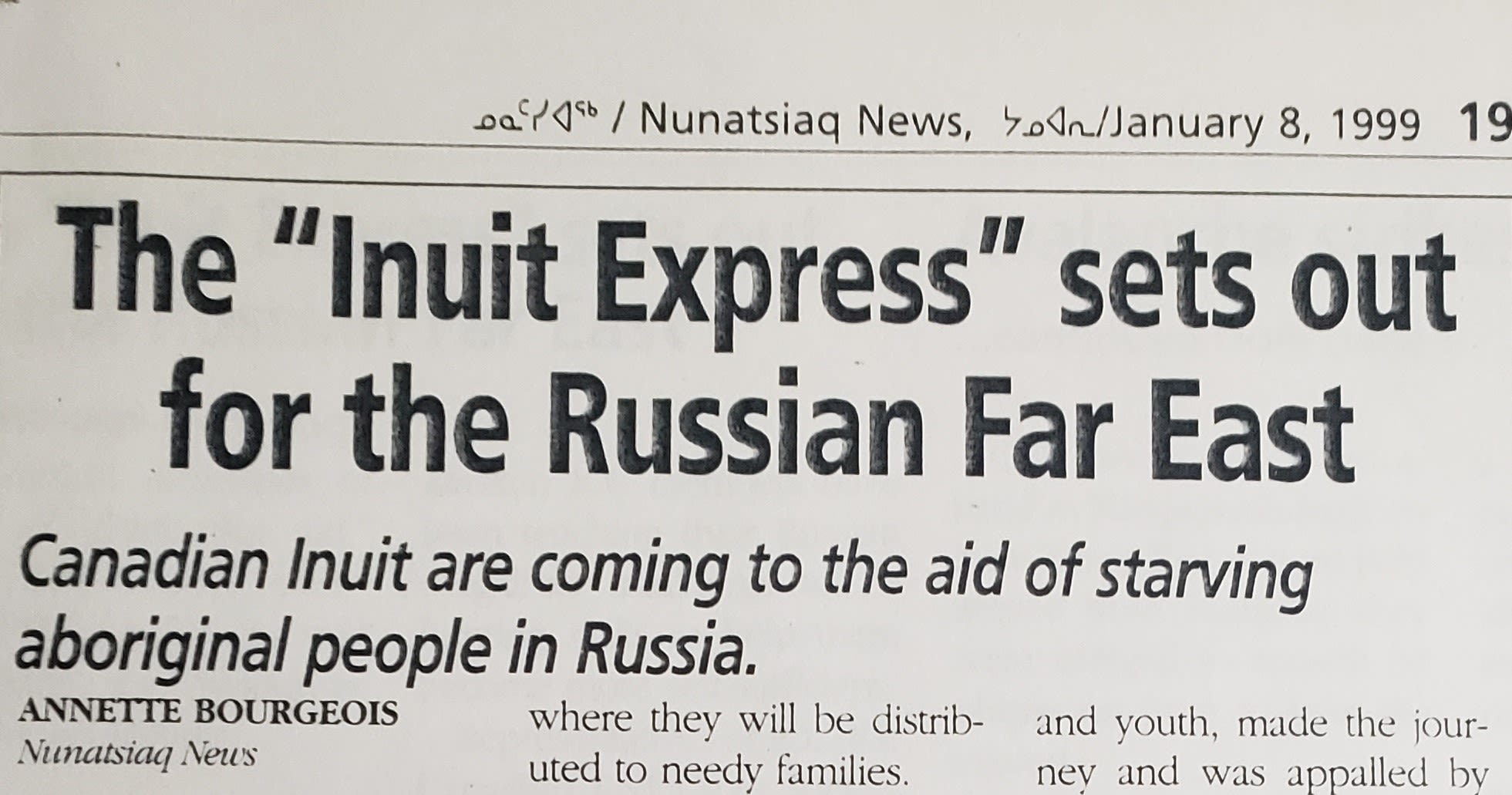
Title from news article in Nunatsiaq News, January 8, 1999.
Title from news article in Nunatsiaq News, January 8, 1999.
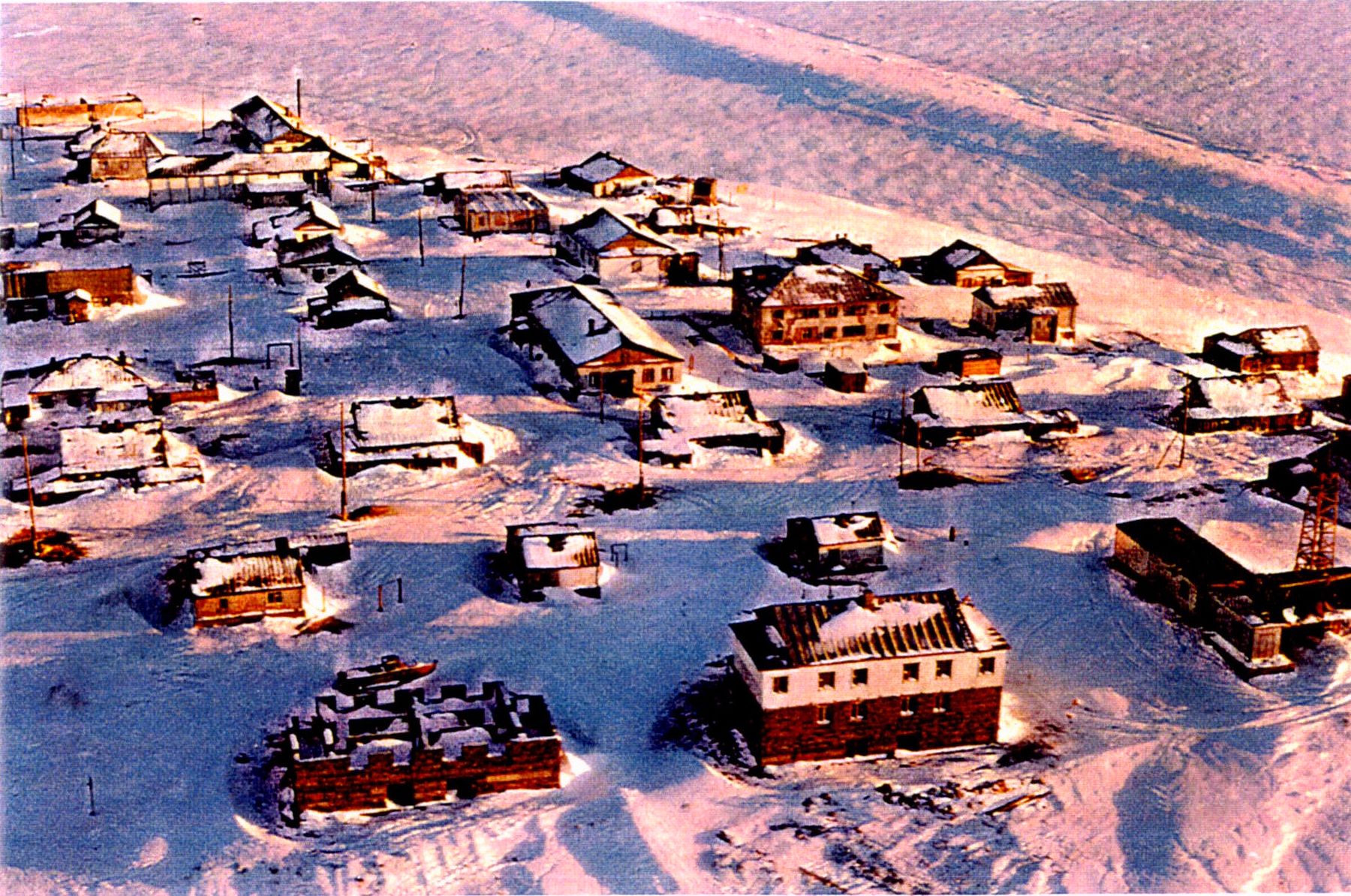
Yanrakynnot, January 8, 1999. Photo credit: Harald Finkler (DIAND/ICC Canada).
Yanrakynnot, January 8, 1999. Photo credit: Harald Finkler (DIAND/ICC Canada).
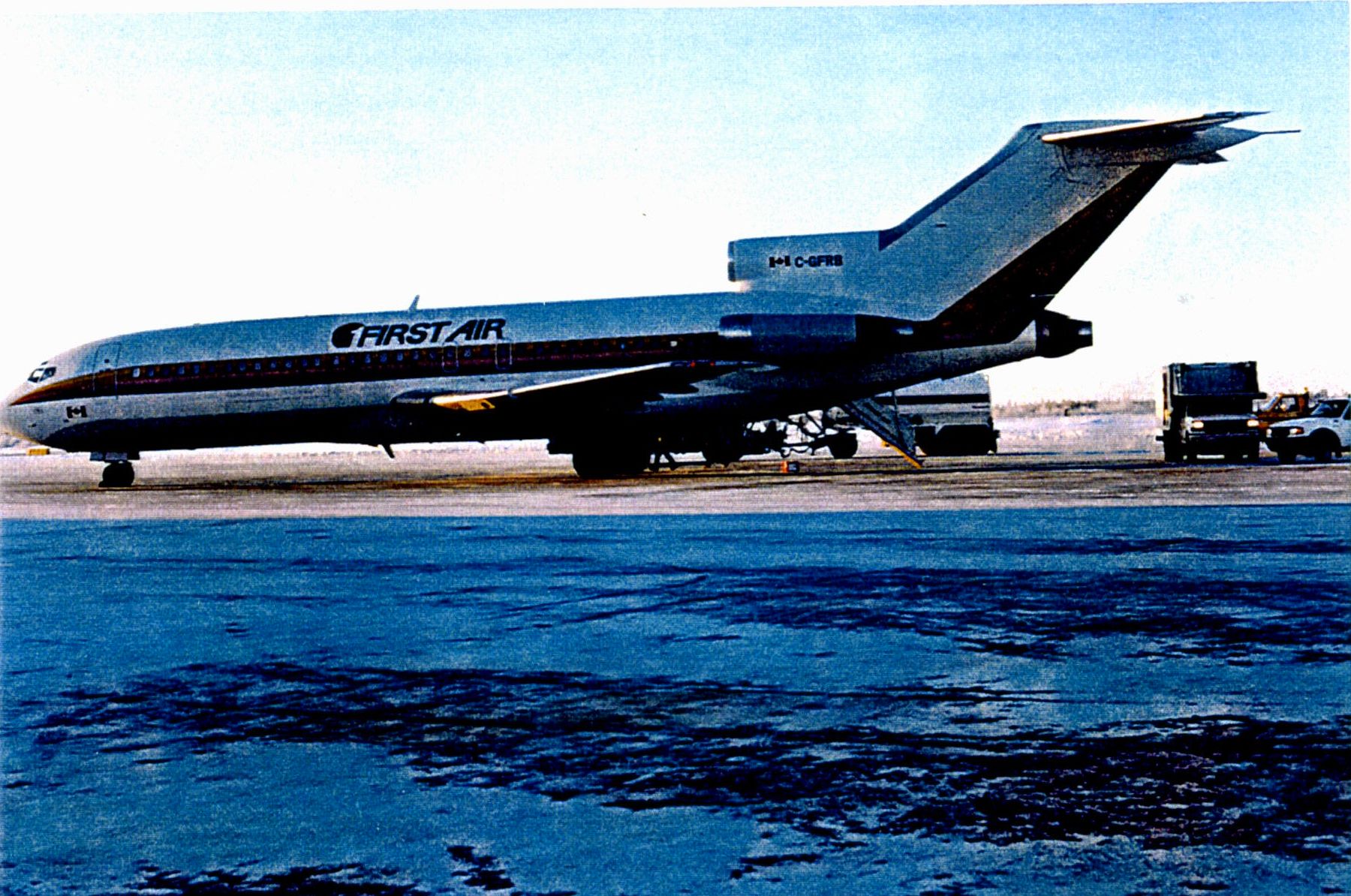
Aid airlift in Yellowknife, January 5, 1999. Photo credit: Harald Finkler (DIAND/ICC Canada).
Aid airlift in Yellowknife, January 5, 1999. Photo credit: Harald Finkler (DIAND/ICC Canada).

Title from news article in the Yellowknifer, January 8, 1999.
Title from news article in the Yellowknifer, January 8, 1999.
Our plan was to quickly ship emergency relief to Chukotka by the end of the year, then start on longer-term missions to the rest of northeastern Russia. This emergency relief mission quickly became known as "The Inuit Express."
So what did the people of Chukotka need? What could be sent immediately?
Food, blankets, candles, and first aid kits - all the supplies were shipped to a private hangar at the Ottawa airport where they were loaded into the plane by volunteers and staff from ICC Canada, Inuit Tapiriit Kanatami, the Canadian Red Cross, and DIAND. Our staff even brought their families along to speed up the packing.

An ICRC food parcel similar to what was given out during this program. Click through to see more information from the Red Cross on their side of the humanitarian aid mission. Photo credit: Canadian Red Cross.
An ICRC food parcel similar to what was given out during this program. Click through to see more information from the Red Cross on their side of the humanitarian aid mission. Photo credit: Canadian Red Cross.
An assembly line of helpers filled each food box with the same supplies: margarine, flour, milk, salt, sugar, vegetable oil, tea, oats, and pasta. This food would supplement the traditional diet of the people of Chukotka during this time of starvation.
Hundreds of boxes of critical supplies were packed into a First Air Boeing 727. As an Inuit-owned airline, First Air charged us almost nothing.
The plane was ready to go on December 18 for delivery over Christmas. However, the Canadian Embassy decided (despite objections from the project team) that the mission should be pushed back to January.
A Christmas Delivery
On January 5th, the Inuit Express took flight from Ottawa.

On the plane were staff from ICC Canada, the Canadian Red Cross, CIDA, and DIAND.
The plane made stops in Yellowknife and Anchorage before crossing the Bering Strait to Chukotka. At each stop, local Inuit came to offer their support to the mission.
The Inuit Express landed in Anadyr, Chukotka on January 6th -
Christmas Eve in Russia!
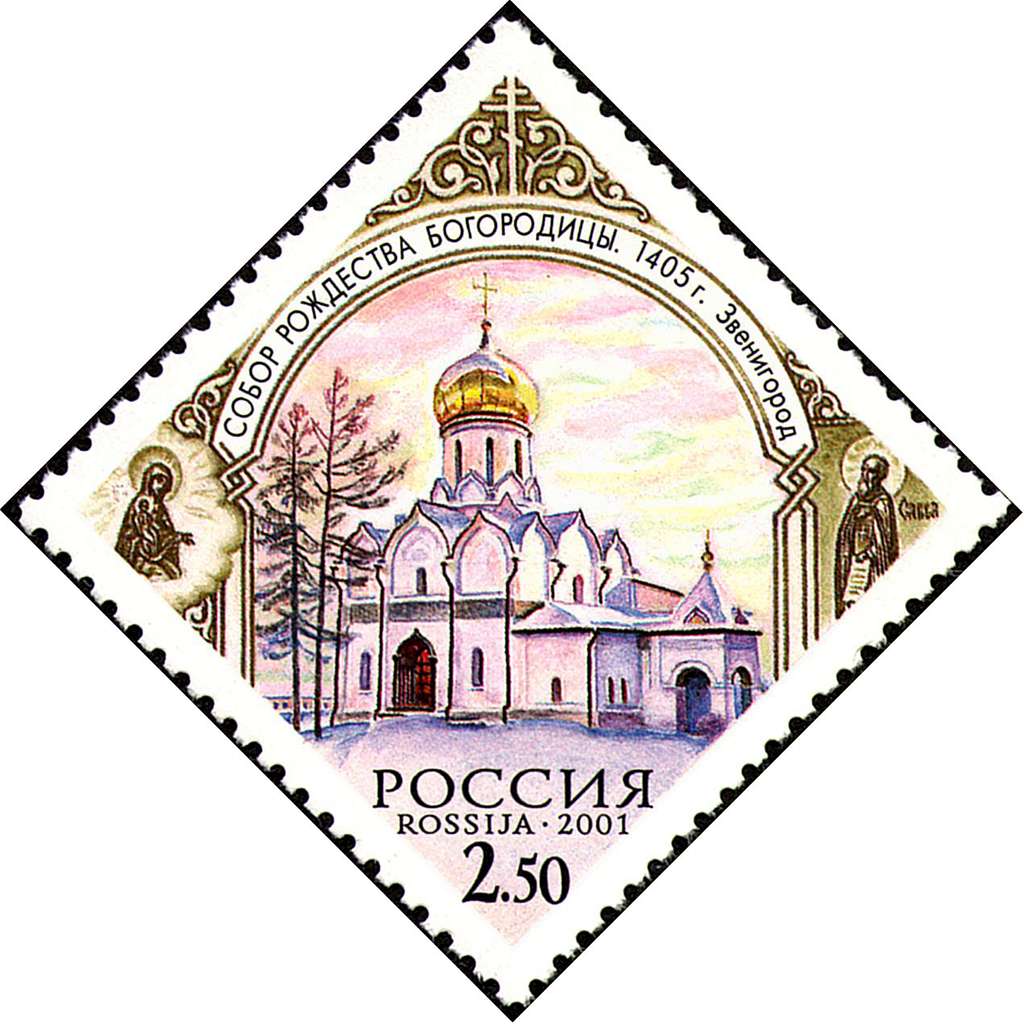
Russian stamp with the Cathedral of the Nativity of the Theotokos in Savvino-Storozhevsky Monastery, Zvenigorod. Public domain.
Russian stamp with the Cathedral of the Nativity of the Theotokos in Savvino-Storozhevsky Monastery, Zvenigorod. Public domain.
"All involved in this project appreciate the political and practical difficulties in Russia of distributing aid. It must go to the people who need it, not to governments."
From Anadyr, the mission split up to deliver supplies by helicopter to small, isolated Yupik and Chukchi villages in the north. The Canadian Red Cross traveled to Lavrentiya and Enurmino, while the ICC team covered Sireniki and Yanrakynnot.
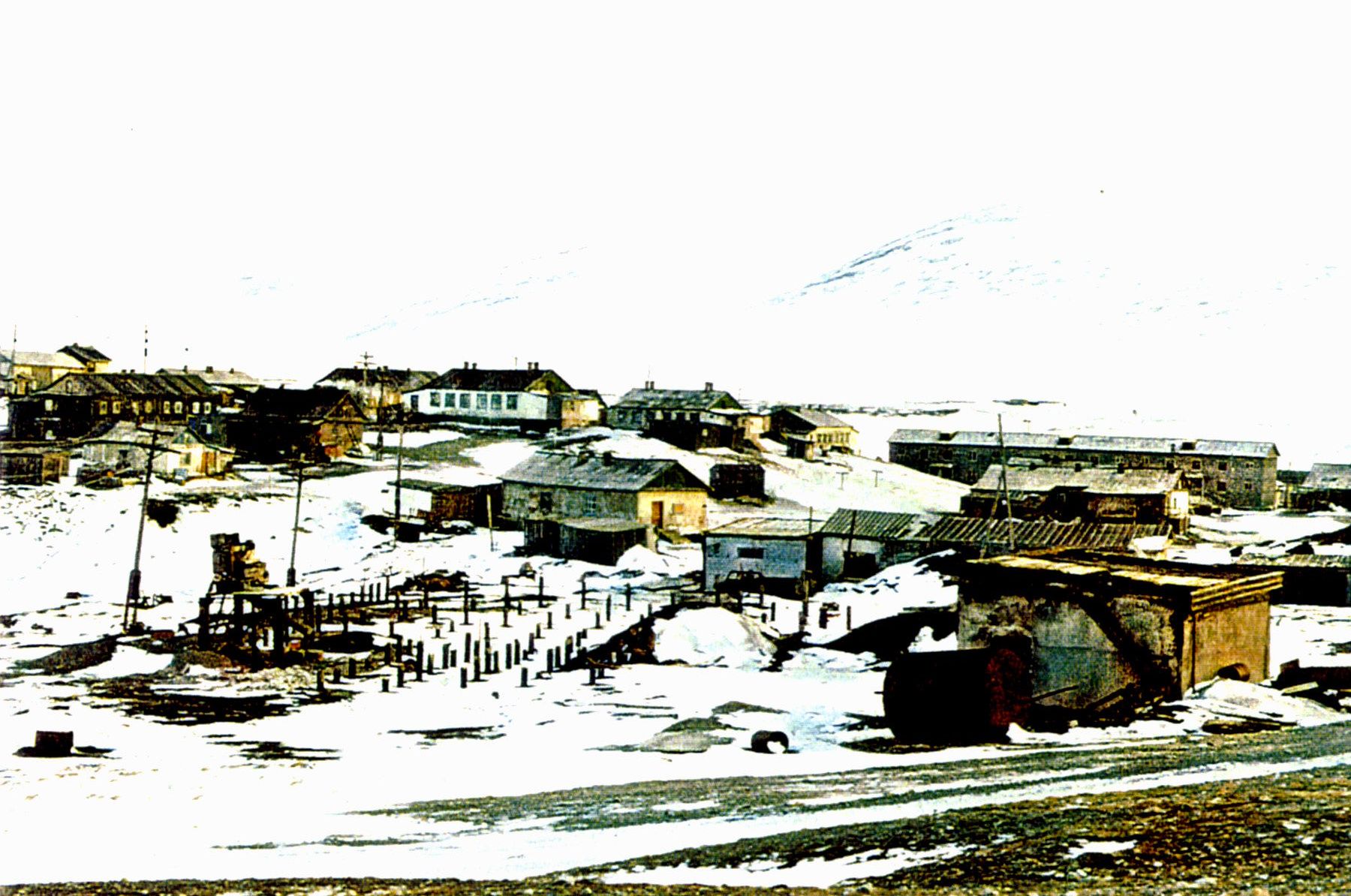
Sireniki, January 7, 1999. Photo credit: Harald Finkler (DIAND/ICC Canada).
Sireniki, January 7, 1999. Photo credit: Harald Finkler (DIAND/ICC Canada).
The high level of corruption in the broken Russian government made it critical to get this aid right into the hands of the people who needed it most.
Leaders from ICC Russia and RAIPON travelled with us to bring aid packages directly to Indigenous communities. Over 1,300 people were given the necessities needed to survive.

Yanrakynnot, January 8, 1999. Photo credit: Harald Finkler (DIAND/ICC Canada).
Yanrakynnot, January 8, 1999. Photo credit: Harald Finkler (DIAND/ICC Canada).
ICC Canada met with many community members, Indigenous leaders, and government officials in Russia over the course of our work.
We did our best to understand their issues and concerns so that we could provide better help.

The mission team traveled back home on January 11 through Nome, Alaska.
ICC Canada and the Red Cross wanted to keep helping. We immediately started planning for future aid and assistance programs.
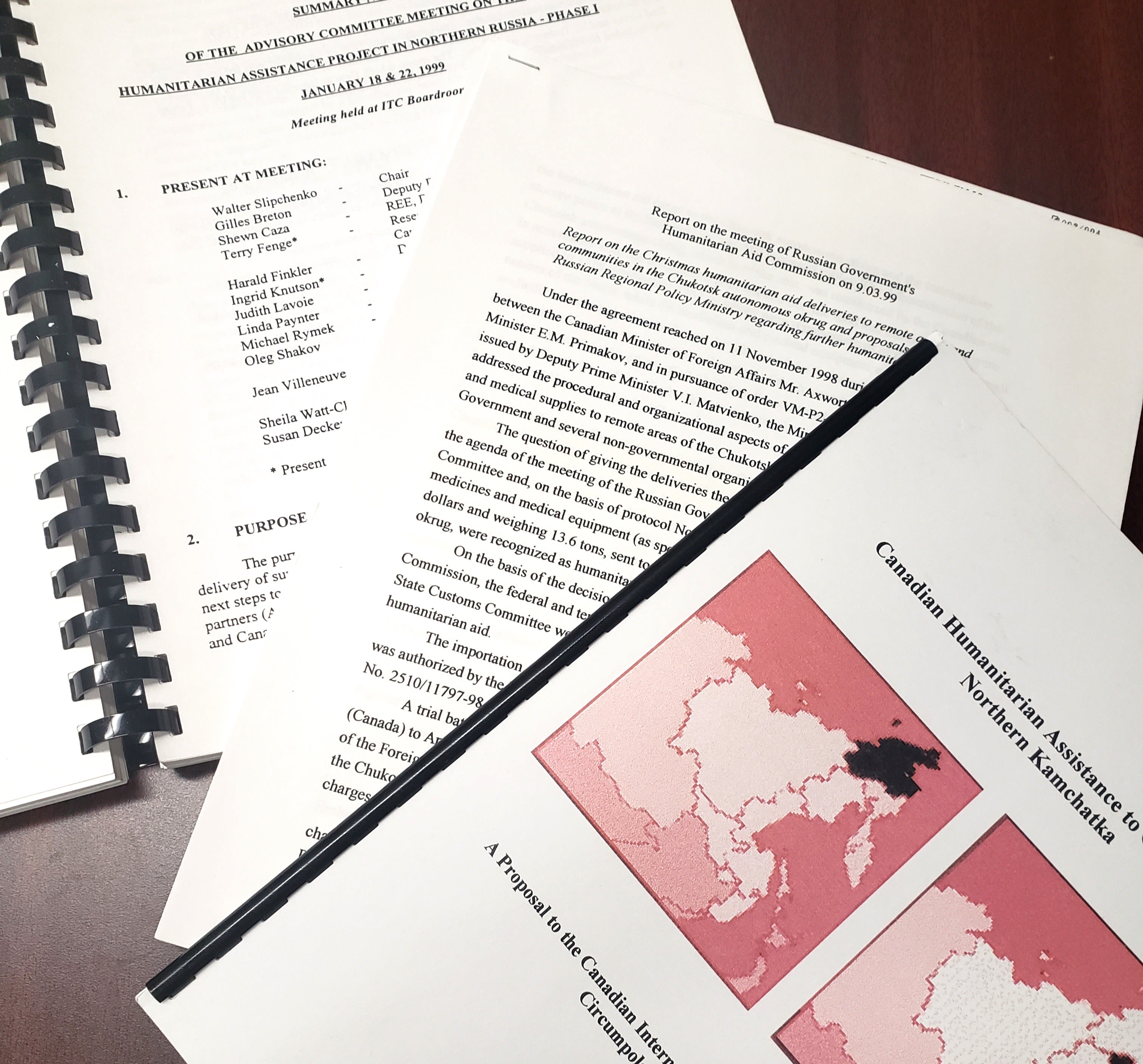
Post-mission meeting reports and a proposal for further humanitarian assistance. Proposal available online. Photo credit: ICC Canada Archives.
Post-mission meeting reports and a proposal for further humanitarian assistance. Proposal available online. Photo credit: ICC Canada Archives.
From start to finish, this whole humanitarian aid project took less than three months.
Extremely fast for an international aid mission!
"This aid was very timely and brought some relief to the people residing in remote communities, thus re-igniting their hope and confidence in the fact that they are remembered and cared for. ... We have been able to prove that Aboriginal organizations, in cooperation with government agencies, can successfully carry out such activities."
- Letter from Sergey Kharyuchi, RAIPON President, to Siila (Sheila) Watt-Cloutier, ICC Canada President, January 28, 1999. From the Summary report on the humanitarian assistance project in Northern Russia.
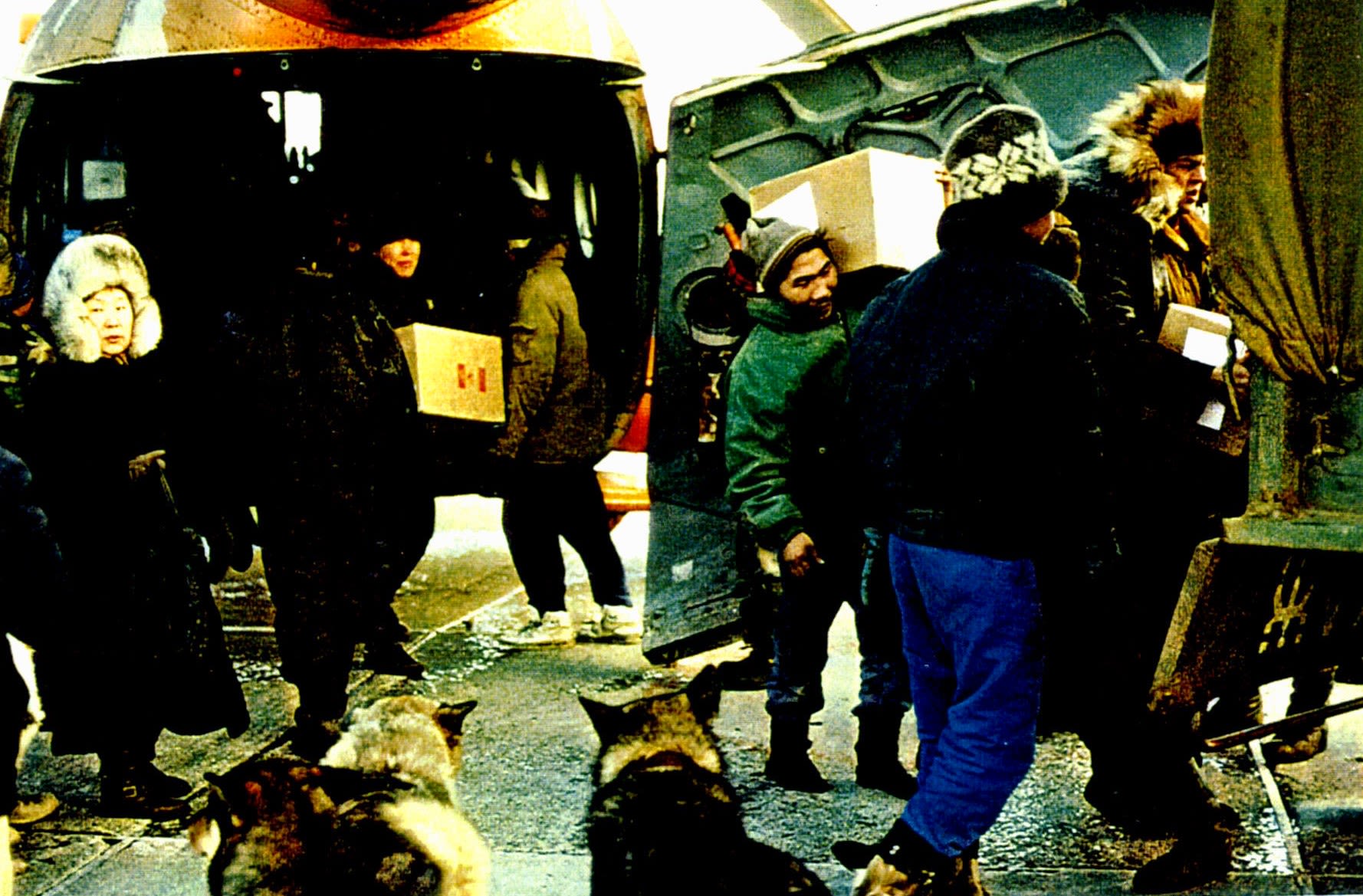
Sireniki, January 7, 1999. Photo credit: Harald Finkler (DIAND/ICC Canada).
Sireniki, January 7, 1999. Photo credit: Harald Finkler (DIAND/ICC Canada).
The Aftermath
ICC Canada achieved its goals: food, relief, and hope were brought to Inuit in Chukotka. RAIPON thanked ICC Canada several times on behalf of the people of Chukotka for our work.
Unfortunately, our plans and proposals for further humanitarian assistance were denied by CIDA. Instead, CIDA started a separate humanitarian aid program with the Canadian Red Cross.
Even though we were no longer involved, ICC passed a resolution in 1999 urging the Red Cross to continue to work with RAIPON on any humanitarian aid programs.
ICC Canada was still determined to help Inuit in Chukotka, no matter what form that help might take.
The documentary The Other Edge of the World is shown on a laptop screen, next to a VHS tape and DVD copy of the film. Photo credit: ICC Canada Archives.
The documentary The Other Edge of the World is shown on a laptop screen, next to a VHS tape and DVD copy of the film. Photo credit: ICC Canada Archives.
The Other Edge of the World
"The minute there's a hurricane, for example, in South America, Honduras, we see all of that in the media immediately. And there's a compassion that wells up in everybody, and everybody wants to do something to help.
In Arctic Russia, we see nothing. We see nothing about these people who are struggling with no food, with no heat, with no electricity, and meager, meager resources. And because we don't see it, we think it doesn't exist."
- Siila (Sheila) Watt-Cloutier, former ICC Canada President,
in The Other Edge of the World
The Other Edge of the World is a documentary film that tells the story of the Canadian Humanitarian Assistance Project to northern Russia.
The Next Steps:
The Canadian Inuit Initiative
ICC Canada's Fundraiser for the Inuit of Chukotka
In 1999, Inuit living in Chukotka continued to endure worsening conditions. An employee of ICC Canada shared the stories she was receiving from her family back in Chukotka:
"Apartments and office buildings, stores and restaurants are in deplorable condition. The windows and doors are broken. No one will take care of them now. There is no money in the budget. “It reminded me of World War II,” [my family member] said in her letter."
"In [Novoye-Chaplino], a community I grew up in, there is no food in the store except sugar, rice, and baking soda. The only food they are eating now is traditional food provided by the local hunters. The local hunters require written permission from local border guards to launch their boats to hunt for whales and walruses. If they return late, the guards withdraw the privilege to hunt for some days. It is also a problem to get fuel to run their motors. People wait a long time to get traditional food from hunters."
- ICC Canada fundraising campaign materials, 1999. Archival description available online.
ICC was working tirelessly to help the Indigenous Peoples of Chukotka, lobbying governments and international aid organizations. However, facing this critical situation, we were determined to provide practical help.
The Canadian government wasn't giving ICC money for another humanitarian aid project. What we did have, though, was connections with Inuit around the world - including the North Slope Borough of Alaska, which was planning another supply shipment to Chukotka.
Unlike previous humanitarian aid, this supply mission focused on equipment for hunting and fishing, to give the Indigenous Peoples of Chukotka the tools to support themselves.
In 1999, ICC Canada started the Canadian Inuit Initiative: a fundraising project that reached out to Inuit communities and organizations across Canada. ICC raffled off handicrafts from Chukotka and received donations from many Inuit and Inuit organizations.
The generosity of Inuit in Canada and the hard work of ICC staff raised $21,000 in less than 2 years!
ICC sent the gathered funds to the North Slope Borough, which had well-established ways of purchasing and shipping hunting equipment over the Bering Strait to Chukotka.
Although crucial and successful, all this humanitarian aid was a stop-gap measure. A project meant to make long-lasting change was still being worked on...
The Next Steps: INRIPP
Institution Building for Northern Russian Indigenous Peoples’ Project
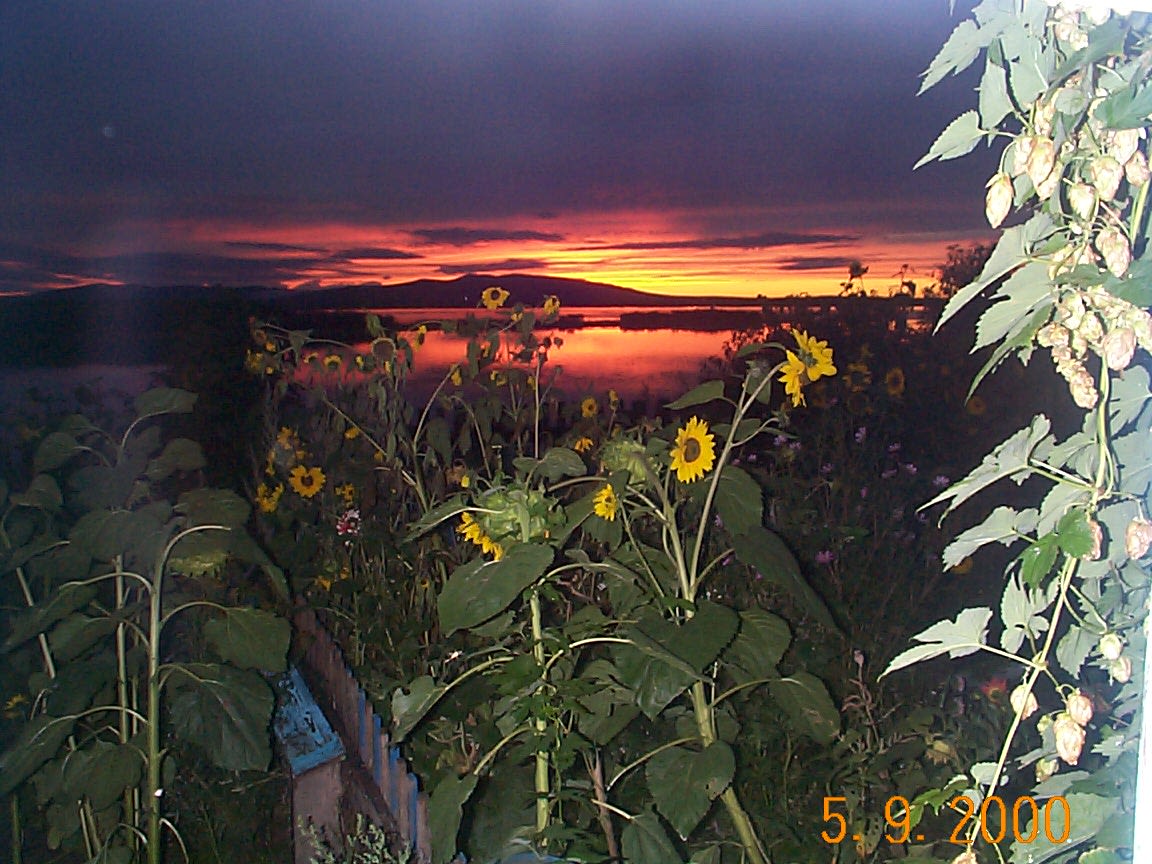
"'If you want to help, do not give the man a fish, teach him how to make fishing tackle and teach him how to use it.'"
- Letter from Larisa Abrutina, Vice-President of RAIPON, to Siila (Sheila) Watt-Cloutier, President of ICC Canada, October 13, 1999. Archival description available online.
While emergency aid saved lives, the Indigenous Peoples of northern Russia needed more than temporary humanitarian assistance.
They needed not just to be able to support themselves, but to be able to speak for themselves, making their voices heard by all leaders around the world.
Because of the strong bonds ICC Canada built with RAIPON and Russian officials, we were ready to make a real difference with the capacity-building project we had been planning since before 1994: the Institution-Building for Northern Russian Indigenous Peoples' Project, or INRIPP.
From 1996 to 2006, ICC Canada worked with Russian Indigenous Peoples on INRIPP and its follow-up, INRIPP-2. Together with RAIPON we proved that Indigenous organizations could partner up across international borders to achieve amazing things.
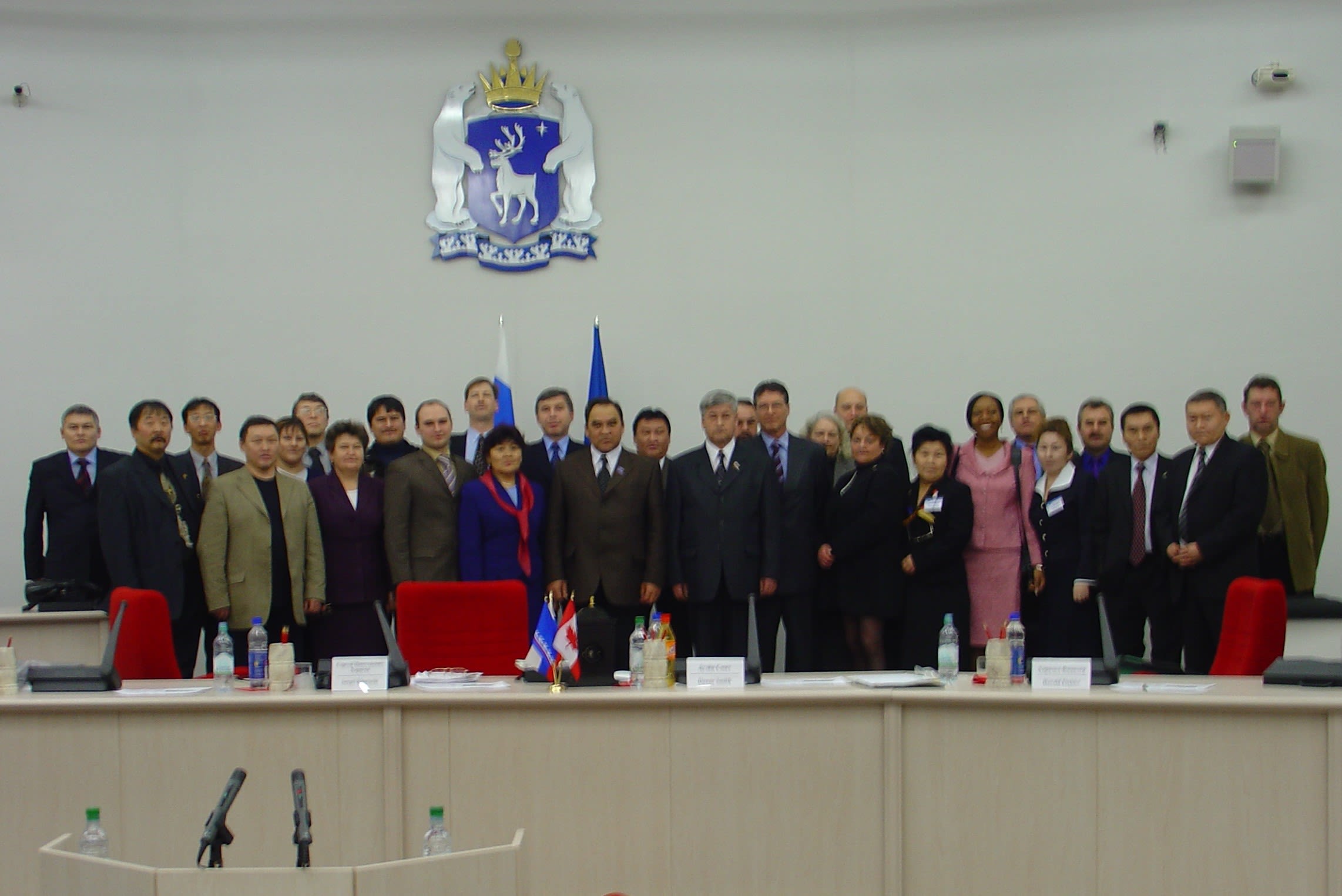
INRIPP-2 Project Steering Committee meeting in Salekhard, 2004. Photo credit: ICC Canada Archives. More INRIPP-2 photos available in ICC Canada Archives.
INRIPP-2 Project Steering Committee meeting in Salekhard, 2004. Photo credit: ICC Canada Archives. More INRIPP-2 photos available in ICC Canada Archives.
INRIPP was all about supporting the Indigenous Peoples of northern Russia in joining national and international discussions. The project overlapped with ICC Canada's humanitarian aid efforts, which only made us more determined to help. You can learn more about the project on ICC Canada Archives.
INRIPP-2 was more business-focused: offering training resources, workshops, and internships, and helping organize sustainable development projects and co-management of natural resources. Even more about this project can be found on ICC Canada Archives.
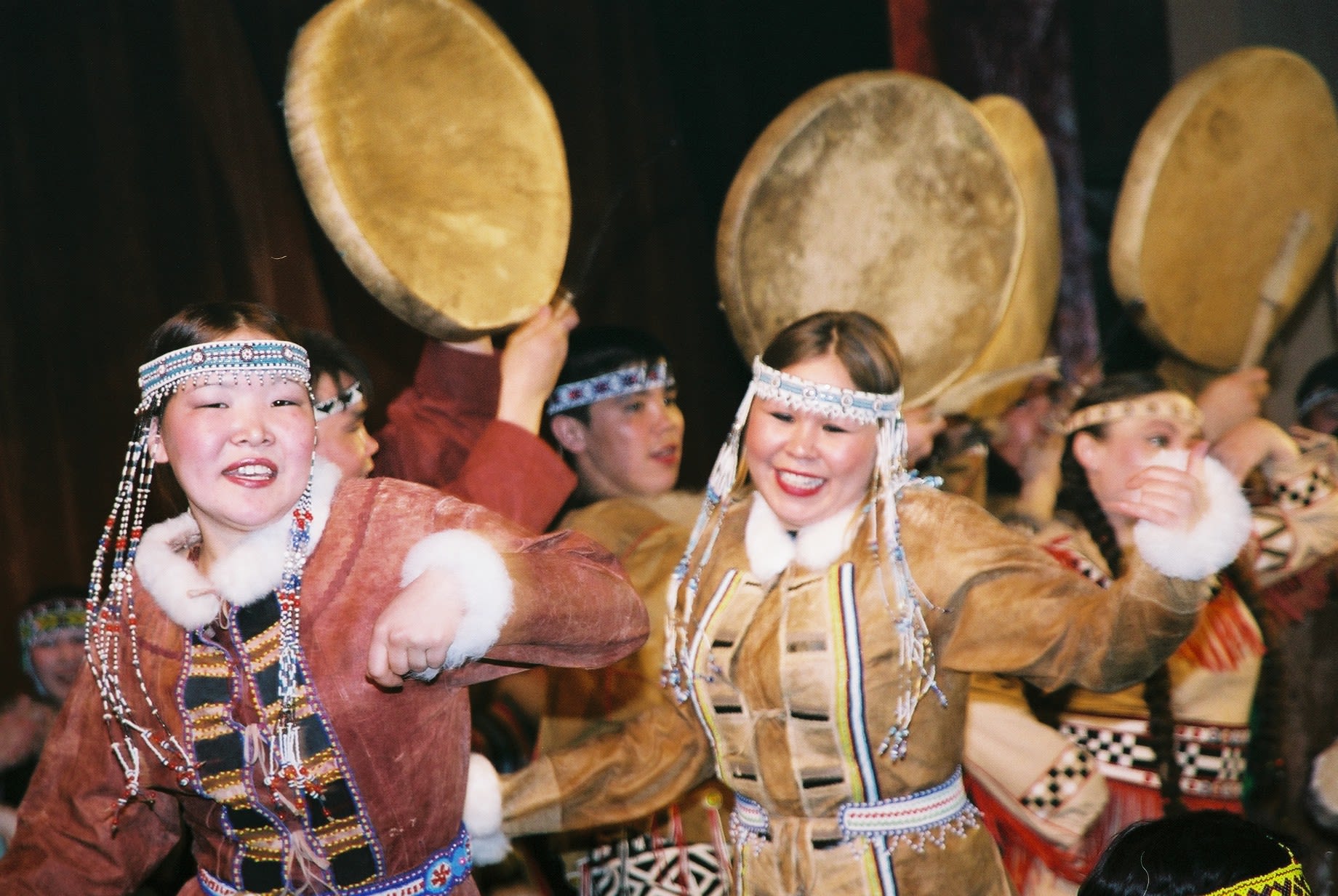
Performers at the RAIPON congress, April 2005. Photo credit: ICC Canada Archives. More INRIPP-2 photos available in ICC Canada Archives.
Performers at the RAIPON congress, April 2005. Photo credit: ICC Canada Archives. More INRIPP-2 photos available in ICC Canada Archives.
ICC Canada's hard work on INRIPP helped build solid foundations for RAIPON, offering the Indigenous Peoples of northern Russia the tools to control their own fates, and not just survive, but thrive.

One Arctic
One People
The Inuit Circumpolar Council continues to work every day to bring Inuit around the world together to solve critical Arctic issues and amplify Inuit voices.
Across Inuit Nunaat - throughout the lands now called Canada, Alaska, Greenland, and Chukotka - we are one people sharing one Arctic, facing one future together.
Extending our hands across artificial borders to our Inuit relatives and building partnerships with Indigenous Peoples across the globe, ICC Canada's history is Inuit history, and we are proud to share it with Inuit all over the world.
We welcome you to explore the ICC Canada Archives website and dive into more of the amazing work that Inuit have done on the international stage.

References:
1st General Assembly, 1977 series. F3-S1, ICC Canada Archives, Ottawa. https://iccc-archives.andornot.com/link/description5090
3rd General Assembly, 1983 series. F3-S3, ICC Canada Archives, Ottawa. https://iccc-archives.andornot.com/link/description4899
5th General Assembly, 1989 series. F3-S5, ICC Canada Archives, Ottawa.
1988 trip to Chukotka series. F2-S7, ICC Canada Archives, Ottawa.
Ashbury, Doug. "In search of aid." Yellowknifer. January 8, 1999, 3.
Bourgeois, Annette. "The "Inuit Express" sets out for the Russian Far East." Nunatsiaq News. January 8, 1999, 19.
Canadian humanitarian aid to Northern Russia series. F1-S10, ICC Canada Archives, Ottawa. https://iccc-archives.andornot.com/link/description3079
ICC Canada, "Can you help Inuit from Chukotka?" advertisement, Inuktitut, 2002. https://www.itk.ca/wp-content/uploads/2016/10/2002-0091-InuktitutMagazine-IUCANS-IULATN-EN-FR.pdf
"ICRC Food Parcel," Canadian Red Cross, accessed September 2, 2023, https://www.redcross.ca/history/artifacts/icrc-food-parcel
INRIPP fonds. F7, ICC Canada Archives, Ottawa. https://iccc-archives.andornot.com/link/description1064
INRIPP-2 fonds. F8, ICC Canada Archives, Ottawa. https://iccc-archives.andornot.com/link/description1771
Kumo, Kazuhiro, and Tamara Litvinenko. 2019. "Post-Soviet Population Dynamics in the Russian Extreme North: A Case of Chukotka." Polar Science, ISAR-5/ Fifth International Symposium on Arctic Research, 21 (September): 58–67. https://doi.org/10.1016/j.polar.2018.11.002.
McAdams, Lisa. "World: International Red Cross And Red Crescent Societies Seek To Help Vulnerable." RadioFreeEurope/RadioLiberty, March 9, 1999. https://www.rferl.org/a/1090759.html
Schodolski, Vincent. "Soviet Bread Prices Skyrocket by 600%." Chicago Tribune. November 13, 1991. https://www.chicagotribune.com/news/ct-xpm-1991-11-13-9104110945-story.html
Walker, Ruth. "Canadian Inuit Help Out Their Russian Kin." The Christian Science Monitor. January 8, 1999, 8.


